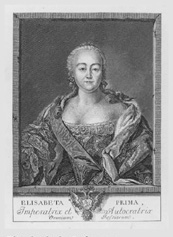The Good, the Bad and the Unready (35 page)
Read The Good, the Bad and the Unready Online
Authors: Robert Easton

Elizabeth, empress of Russia, 1709–62
Elizabeth Petrovna was known throughout the courts of Europe as ‘1’Infame Catin du Nord’, or ‘the Northern Harlot’, but her
reputation as nothing but a trollop is unwarranted. What one can say with certainty is that Elizabeth was a woman of passion.
• She was a passionate patriot. Like her father Peter the
GREAT
, she was held in the highest esteem by her army and her first years of power showed her to be an astute, if painfully procrastinating, governor of Russia.
• She was a passionate hostess. The beautiful, popular and vivacious Elizabeth provided guests at court with lavish feasts and entertainments. Childless herself, she adored holding children’s parties, serving up miniature food on miniature plates on miniature tables.
• She was passionate about her appearance. One of her weaknesses was fine clothes, and unlike most she had the means of indulging it. On her death 15,000 dresses were discovered in her wardrobes.
• She was passionate about matters spiritual. Elizabeth was extremely religious, yet also extremely superstitious. If a fly, for instance, settled on her pen or paper when she was on the point of signing a bill, the document would be put to one side for another day.
• She was a passionate sensualist. The French ambassador found her disgusting, alluding in various dispatches to her deplorable indolence, her delight in being surrounded by riff-raff, and her ‘voluptuous vanity’. Her favourite luxury, we are told, was to lie in bed and have her feet scratched by her ladies-in-waiting.

Elizabeth the
Infamous
Irish High Kings
Beginning with the extravagantly named, and probably legendary, ‘Slainge the Firbolg’ of about 2000 BC, royal cognomens in Irish genealogies make intriguing reading. Most Irish histories start with the fourth-century AD king ‘Niall of the Nine Hostages’, but there is sufficient evidence to trace high kings back several centuries before him. Some of these kings were given nicknames, and below is a list, beginning at AD 1, of those so honoured.
First Century
AD
Nuada the White
Lugaide of the Red Stripes
Conchobar of the Red Brows
Crimthann the Modest Warrior
Carbery Cathead
Second Century
Tuathal the Legitimate
Fedlimid the Lawgiver
Conn of the Hundred Battles
Third Century
Art the Solitary
Fergus of the Black Teeth
Fourth Century
Eochaid Slave-Lord
Niall of the Nine Hostages
Sixth Century
Domnall the Deceitful
Colman the Celebrated
Seventh Century
Aed of the Ague
Suibne the Little
Finnechtae the Festive
Eighth Century
Aed the Handsome
Niall of the Showers
Ninth Century
Aed the Dignified
Aed White-Hair
Flann the Fox
Early Tenth Century
Niall Black-Knee
 William the
William the
Iron Arm
see
the
SONS OF TANCRED
 Arthur the
Arthur the
Iron Duke
Arthur Wellesley, duke of Wellington, 1769–1852
Was Wellington named ‘the Iron Duke’, as one Victorian biographer has proposed, after a steamboat that plied between
Liverpool and Dublin? Or did the press dub him so after he installed iron shutters at Apsley House in 1828 to fend off an angry mob? Without question, Wellington himself would have preferred to believe the name derived from either the harsh discipline he imposed on his regiments or his rigid opposition to parliamentary reforms.
After his famous victory at Waterloo in 1815 over Napoleon the
LITTLE CORPORAL
, and before any ferrous appellations had become common currency, Wellington had been variously
heralded as ‘the Great Duke’ and ‘the Saviour of the Nations’. His most popular nicknames throughout his life, however, celebrated neither his military success nor his political character, but his vast and unmistakable nose. Supporters and critics alike knew him as ‘Conky’, ‘Old Nosey’ and ‘Beaky’, while even poets were fascinated by his immense aquiline proboscis. ‘Proud Wellington,’ wrote Byron, ‘with eagle beak so called / That nose, the hook where he suspends the world.’
 Iron-Hand
Iron-Hand
Götz von Berlichingen, German knight, 1480–1562
No metaphor in use here. The Germans named their hero ‘Iron-Hand’ precisely because he had an artificial iron hand, replacing one that had been blown off at the siege of Landshut in 1505.
 Ernest the
Ernest the
Iron-handed
Ernest, duke of Austria, 1383–1424
Ernest’s uncompromising and relentless warring against his brothers Frederick and Leopold accounts for his epithet, but in a wonderful uxorial nickname transference it is Ernest’s wife who really deserves this soubriquet. Cymburga, a Polish noblewoman, was the perfect partner for the adamantine Ernest. Historians record that she could crack nuts with her fingers and drive nails into wood with her bare fist.
 Edmund
Edmund
Ironside
Edmund II, king of England, c.993–1016
The sixteenth-century antiquary William Camden states that Edmund’s nickname derived from his valour on the battlefield. Others claim, however, that the king was so called because he wore his armour all day, every day. He undoubtedly had use for it, fighting no fewer than five battles with ‘Canute the Great’ (
see
GREAT
…
BUT NOT THAT GREAT
) within a year of occupying the English throne. At the battle of Ashingdon, a chink in his
battered iron armour was found, and Edmund received a fatal wound.
 Frederick
Frederick
Irontooth
Frederick II, margrave of Brandenburg, 1413–71
At the turn of the fifteenth century Berlin was an unhygienic outpost of the Holy Roman Empire, bogged down in lawlessness and ravaged by plague. In 1411 Sigismund the
LIGHT OF THE WORLD
asked the noblemen of the House of Hohenzollern to quash the province’s robber barons and restore law and order. This they did with admirable speed. When, however, the young Frederick assumed control of the region, some of the more arrogant burghers presumed his inexperience spelled liberality. Not so. Frederick immediately disbanded the courts, seized private property and ‘bit off’ the hand of anyone who dared to take liberties; hence his nickname ‘Dent de Fer’.
 Nicholas the
Nicholas the
Iron Tsar